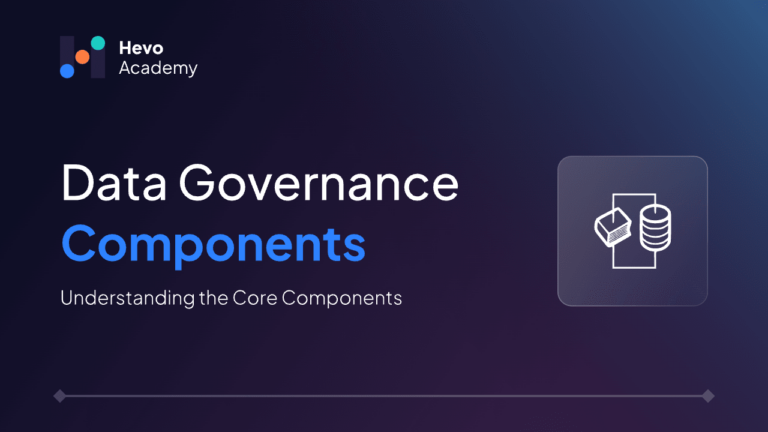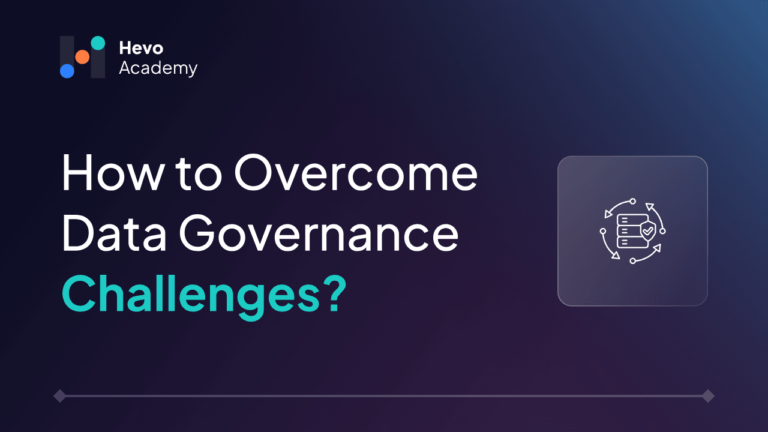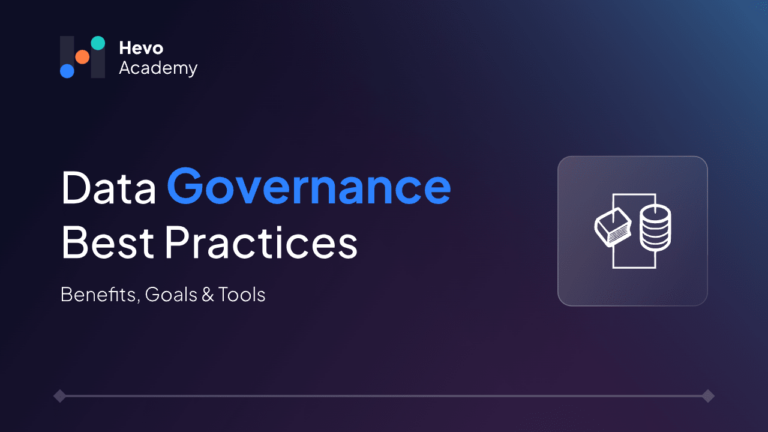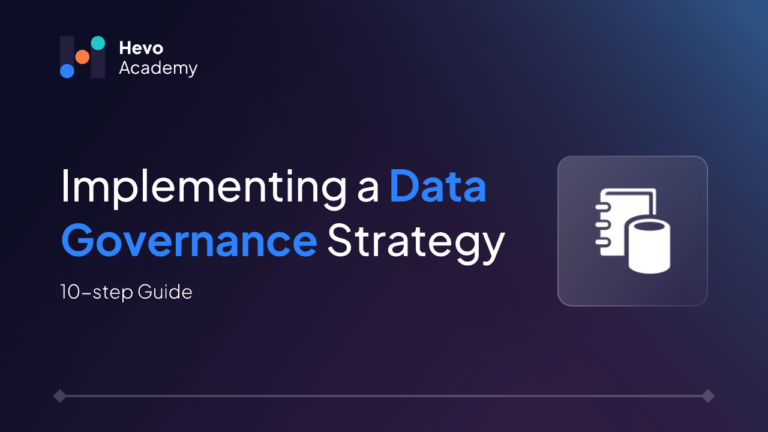Data governance helps to increase data reliability, consistency, and accuracy. When a data governance program is implemented, organizations can ensure that the data being used is free from discrepancies and errors. The assessment of data governance is necessary as it helps to evaluate your data ecosystem and assess data maturity against the benchmarks of the industry. They can also find any weaknesses and shortcomings of the data governance program. This article discusses data governance, data governance assessment, and its importance, along with steps to implement data governance assessment and some best practices.
Table of Contents
What is data governance?
Data governance provides standards and rules that help organizations control, protect, and manage data. The key components of data governance include data governance strategy, data governance roles and responsibilities, data governance policies, data quality management, data governance process, data protection, data integration and interoperability, data stewardship, and key performance indicators.
Data governance increases data quality to ensure that it is accurate, consistent and secure. For example, healthcare businesses implement data governance to protect their patient information to make sure it complies with Health Insurance Portability and Accountability Act (HIPAA) compliance.
What is a Data Governance Assessment?
As we know, data management is an ever-changing field. Organizations can overcome several obstacles to guarantee the quality, security, and compliance of their data assets by doing data governance assessments. With the use of these evaluations and assessments organizations can analyze their data management procedures. They can also find any weaknesses and shortcomings of their program. They can develop workable plans to deal with any kind of data threats and breaches.
Organizations always receive many benefits from data governance programs. The main reason is that they give a thorough understanding of the data environment within an organization, which facilitates improved decision-making and promotes business objectives. There are some data management frameworks like EDM council’s DCAM and CDMC that offer structured ways to assess the data ecosystem and evaluate data maturity against the benchmarks of the industry.
Need for Data Governance Assessment
Data governance assessment helps to identify data risks, set improvement priorities, and create a plan to improve data governance programs. They also make regulatory compliance easier because their procedure is according to regulations. They help to improve data quality, lessen data breaches, and boost the effectiveness of data management as a whole. As far as data governance evaluations are concerned, they are an ongoing process. Organizations need to regularly check their data maturity level. These evaluations help to guarantee continuous improvement. These evaluations assess important performance indicators and highlight any areas that should be improved. Organizations can more effectively handle data risks and adjust to data management changes when regular evaluations are conducted.
Looking to improve data governance and data management? Hevo can help. Hevo is a no-code data pipeline platform that enables seamless migration of data from various sources to destinations like databases and data warehouses. Hevo offers:
- Real-time Data Monitoring: Ensure data accuracy and consistency with continuous monitoring of data.
- Automated Data Mapping: Streamline data governance by automatically mapping and transforming data to fit organizational standards.
- Secure Data Transfers: Protect sensitive data with end-to-end encryption, ensuring compliance with regulatory requirements.
Try Hevo today and elevate your data governance and management needs.
Get Started with Hevo for FreeStep by Step procedure for creating data governance assessment
The procedure for creating a data governance assessment includes the following 8 steps:
- Evaluate the existing condition of data management
Understand your present data structure, policies, and practices. This includes evaluating how data is gathered, stored, processed, and used in the organization. Examine present data quality and management processes. A detailed examination of the current situation will give a baseline from which to measure improvement. Using data dictionary tools helps to identify gaps in data quality and management by clearly outlining data elements, relationships, and usage across systems.
- Define the aims and objectives for data governance
Make what you intend to achieve with your data governance program clear. This could include improving data quality, adhering to data protection rules, facilitating data exchange, strengthening data security, or assisting decision-making. Clearly defined objectives will guide the creation and implementation of your data governance strategy.
- Identify stakeholders
Identify all essential stakeholders who will be involved in the data governance initiative. This includes executives, data owners, users, data custodians, and IT staff.
- Assess organizational capability
Assess your organization’s readiness to adopt a data governance framework. This includes evaluating culture, talent levels, resources, and the organization’s capacity to adapt. Understanding the culture is critical since resistance to change can be a significant impediment to establishing data governance.
- Determine the data governance maturity level
Use a recognised methodology, such as the Data Governance Maturity methodology, to evaluate organization’s data governance maturity. This helps in the identification of deficiencies and opportunities for improvement.
- Identify the risks and challenges
Acknowledge the dangers and obstacles that could make your data governance program less successful. These include a shortage of skilled and competent workers, their capacity to change, financial limits, budget restrictions, or technological limitations. Mitigation techniques should be implemented to deal with these issues.
- Develop a roadmap
Create an implementation roadmap for data governance based on your assessment. This should create a clear guideline for the team that can help to understand who is responsible for what, when, and how progress will be measured
- Continuously evaluate
After your data governance program is in place, keep an eye on its efficacy and make any necessary modifications. This evaluation is incremental and it includes routinely assessment of the quality of the data and the program’s overall effectiveness to achieve its goals.
Key questions to include in data governance assessment
Some of the key questions that should be included in data governance assessment are as follows:
- Have we defined our goals and objectives for implementing a data governance framework?
- Have we identified potential risks that can arise when implementing a data governance program?
- Is our organization’s culture ready to embrace the changes caused by data governance?
- Do we have the resources and expertise that are required to implement our data governance program?
- Does our organization have data quality management procedures in place right now?
- Have we recognized any risks or difficulties that could arise while putting a data governance program into place?
- Are we prepared to set aside money for the adoption of data governance?
- Have we used a standard methodology to determine our data governance maturity level?
- What data flow issues are we trying to resolve?
- Do we recognize the areas in which our present data governance practice needs to be improved and the deficiencies in it?
- Do we have a procedure in place for regularly evaluating our program for data governance?
Best Practices for Effective Data Governance Assessment
Some of the best practices for effective data governance assessment are as follows:
- Do regular assessments to identify what changes should be made. Data governance assessment is an incremental process, so frequent evaluations are the key to effective data governance programs.
- Check all data security practices to ensure that data is safe without any privacy breaches.
- Made continuous improvements in data governance programs according to the increasing needs of the business, people, and technology.
- Engage all the key stakeholders and relevant people in the process. This can help to ensure that data governance programs are implemented according to the objectives.
- Implement all the key performance measures that need to make sure the data governance is increasing instead of decreasing after these improvements.
- Train and guide all employees on data governance principles and data governance assessment to make sure they are well aware of its importance.
- Document the results of the data governance assessment and use them over time.
Conclusion
Data governance assessment is an ongoing process. Organizations should regularly examine their data maturity to make sure that there is a continuous improvement in their data governance program. These evaluations assess some of the important performance indicators. It mentions what needs to be changed in order to enhance the efficiency of the organization. Organizations can more effectively handle data risks and adjust to data management changes that arise with time. Data governance evaluations are critical for organizations that want to address data risks, increase data quality, and maintain regulatory compliance. By carrying out these evaluations and putting targeted solutions into place, organizations may create a strong data governance framework that supports their strategic goals.
Schedule a personalized demo with Hevo for seamless data integration.
FAQs
1. What is data governance assessment?
Data governance assessment helps organizations to ensure the security, protection, quality and compliance of data with regulations by evaluating it across the standards. With the use of these evaluations and assessments organizations can analyze their data management procedures. They can also find any weaknesses and shortcomings of their program.
2. What are the 3 pillars of data governance?
The 3 pillars of data governance include data management, data policies, and data stewardship.
3. What are examples of data governance?
Data governance helps in protecting data. It ensures that only authorized people can access certain data. For example, the company’s employee salary information is only accessible to the payroll team. A person from the IT department or operations department cannot have access to the salary information. Another example is patient data, which is assembled by only relevant people from the health department.
4. What is the primary goal of data governance?
The primary goal of data governance is to increase data reliability, quality, consistency, and accuracy. It also makes sure that data is handled according to regulatory compliance so that the organization avoids legal complications.






